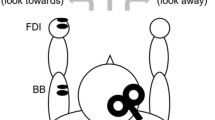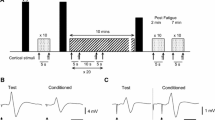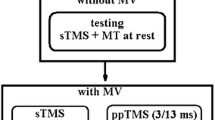Abstract
The short-latency electromyographic response evoked by transcranial magnetic stimulation (MEP) increases in size during fatigue, but the mechanisms are unclear. Because large changes occur in the muscle action potential, we tested whether changes in the response to stimulation of the peripheral motor nerve could fully account for the increase in the MEP. Subjects (n=8) performed sustained maximal voluntary contractions (MVCs) of the right elbow flexors for 2 min. During the contraction, the MEP and the response to supramaximal stimulation of motor-nerve fibres in the brachial plexus were alternately recorded. During the contraction, responses to motor-nerve stimulation increased in area by 87±35% (mean±SD) in the biceps brachii and 74±30% in the brachioradialis, but the area of the MEPs increased by 153±86% and 175±122%, respectively. Thus, the increase in the MEP was greater than the increase in the peripheral M-wave. The onset latency of the MEP in the biceps brachii increased by 0.7±0.6 ms (range: –0.2 to 1.9 ms) during the sustained contraction. A smaller increase occurred in response to peripheral nerve stimulation (0.3±0.3 ms; from –0.3 to 0.9 ms). In the contralateral elbow flexors, neither responses to transcranial magnetic stimulation nor responses to motor-nerve stimulation changed in size or latency. During the sustained contraction, the short silent period after stimulation of the peripheral nerve (48±5 ms in biceps brachii and 48±4 ms in brachioradialis) increased in duration by about 12 ms (to 61±12 ms and 60±9 ms, respectively), whereas the silent period following transcranial magnetic stimulation increased from 238±39 ms in biceps brachii and 243±34 ms in brachioradialis to 325±41 ms and 343±42 ms, respectively. During a sustained MVC, while the motor responses to peripheral and to cortical stimulation grow concurrently, growth of the MEP cannot be entirely accounted for by changes in the muscle action potential. Hence, some of the increase in MEP size during fatigue must reflect changes in the central nervous system. Increased latency of the MEPs and lengthening of the peripherally evoked silent period are consistent with decreased excitability of the alpha motoneurone pool. Thus, an increased response from the motor cortex to the magnetic stimulus remains a likely contributor to the increase in the size of the MEP in fatigue.
Similar content being viewed by others
Author information
Authors and Affiliations
Additional information
Received: 11 September 1998 / Accepted: 28 January 1999
Rights and permissions
About this article
Cite this article
Taylor, J., Butler, J. & Gandevia, S. Altered responses of human elbow flexors to peripheral-nerve and cortical stimulation during a sustained maximal voluntary contraction. Exp Brain Res 127, 108–115 (1999). https://doi.org/10.1007/s002210050779
Issue Date:
DOI: https://doi.org/10.1007/s002210050779




